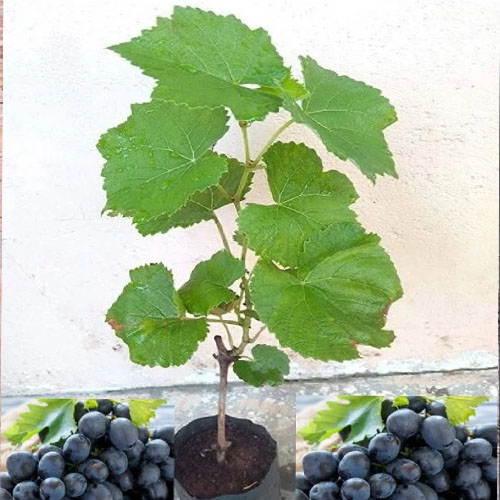Grapes Plants
Grape Plants (Vitis vinifera and other species) are widely cultivated for their sweet fruits, which are used fresh, dried (as raisins), or fermented to produce wine. Grapes are versatile plants that can be grown in various climates and are appreciated for their delicious fruit and ornamental value. Here's a comprehensive guide to understanding and growing grape plants:
Characteristics of Grape Plants
-
Size and Growth Habit:
- Grape plants are woody perennial vines that can grow quite large, often reaching lengths of 30-50 feet (9-15 meters) or more if not pruned.
- They have a climbing growth habit, using tendrils to attach themselves to supports such as trellises, arbors, or fences.
-
Leaves:
- Grape leaves are large, lobed, and typically have a serrated edge. They are arranged alternately along the stems.
- The leaves are usually green, but some varieties can have a reddish or purple tint.
-
Flowers:
- Grape flowers are small, greenish, and grow in clusters called inflorescences.
- They are typically self-pollinating, meaning they can produce fruit without the need for another plant.
-
Fruit:
- Grapes grow in clusters and vary in size, color, and flavor depending on the variety. Common colors include green, red, purple, and black.
- The fruit is a berry, typically round or oval, with smooth skin and a juicy interior containing seeds. Seedless varieties are also popular.
- Grapes are high in sugars and contain vitamins like vitamin C and K, as well as antioxidants such as resveratrol.
-
Lifespan:
- Grape vines can live and produce fruit for many decades, with some well-cared-for vines producing for over 100 years.
Growing Conditions
-
Climate:
- Grapes thrive in temperate climates with warm, dry summers and cool winters. They require a period of dormancy during the winter.
- They are generally hardy in USDA zones 4-10, depending on the variety.
-
Soil:
- Grapes prefer well-draining soil with a neutral to slightly acidic pH (around 5.5-7.0).
- Sandy loam or loamy soils are ideal. Good drainage is essential to prevent root rot.
-
Sunlight:
- Grapes require full sun for optimal growth and fruit production, needing at least 6-8 hours of direct sunlight per day.
- Adequate sunlight is crucial for fruit ripening and flavor development.
-
Watering:
- While young vines need regular watering to establish a strong root system, mature grape vines are relatively drought-tolerant.
- Overwatering can lead to root rot, so it’s essential to allow the soil to dry out slightly between watering.
Care Requirements
-
Support Structures:
- Grapes are climbing vines that require support structures like trellises, arbors, or fences to grow properly.
- Training the vines onto these structures helps improve air circulation, sunlight exposure, and ease of harvest.
-
Pruning:
- Pruning is essential for grape vine health, fruit quality, and ease of management. It helps to control vine size and shape, remove dead or diseased wood, and improve air circulation.
- Pruning is typically done during the dormant season (late winter to early spring) to encourage vigorous growth in the spring and summer.
-
Fertilization:
- Grapes generally do not require heavy fertilization. Applying a balanced fertilizer in early spring can help support growth.
- Over-fertilization, especially with nitrogen, can lead to excessive vine growth and poor fruit production.
-
Pest and Disease Management:
- Common pests affecting grapes include grape berry moths, aphids, and leafhoppers. Diseases such as powdery mildew, downy mildew, and botrytis bunch rot are also common.
- Implementing integrated pest management (IPM) practices, such as regular monitoring, proper pruning for air circulation, and using organic or chemical controls as needed, can help manage these issues.
-
Mulching:
- Mulching around the base of grape vines helps retain soil moisture, suppress weeds, and regulate soil temperature.
- Use organic mulch like straw, wood chips, or compost, but keep mulch a few inches away from the trunk to prevent rot.
-
Harvesting:
- Harvest grapes when they are fully ripe, as they do not continue to ripen once picked. Taste is the best indicator of ripeness.
- Grapes are usually harvested by hand using pruning shears to cut the clusters from the vine. Harvesting typically occurs in late summer to early fall, depending on the variety and climate.
Additional Tips
-
Training and Trellising:
- Proper training and trellising techniques, such as cane pruning or spur pruning, are essential for managing grape growth and maximizing fruit production. Training should begin in the first year after planting.
-
Propagation:
- Grapes can be propagated from hardwood cuttings, layering, or grafting. Hardwood cuttings are the most common method for home gardeners.
-
Winter Protection:
- In colder climates, some grape varieties may require winter protection, such as mulching or covering with burlap to prevent damage from frost and cold winds.
-
Variety Selection:
- Choose grape varieties suited to your climate and intended use (fresh eating, wine-making, raisins, etc.). Popular varieties include Concord (juice and fresh eating), Thompson Seedless (table grapes and raisins), and Cabernet Sauvignon (wine-making).
-
Soil Testing:
- Conduct a soil test before planting to determine nutrient levels and pH, and amend the soil as necessary to provide optimal conditions for grape growth.
-
Weed Control:
- Keep the area around the base of the vine free from weeds, which can compete for water and nutrients and harbor pests and diseases.
If you have any specific questions about growing or caring for grape plants or need more details on a particular variety, feel free to ask!


